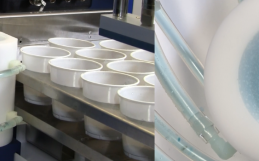Canfor owns and operates the Prince George Pulp Mill in Prince George, British Columbia, Canada. They have been successfully employing the rapid, green and safe PeCOD chemical oxygen demand (COD) method for improved effluent process control which has led to significant cost savings for the mill. This year at PaperWeek 2021, Canfor presented the impact PeCOD 10-minute Biochemical Oxygen Demand (BOD) results had during a 4 week COVID related operations curtailment.
Use of COD Analyzer Data for Improved Control of Aeration and Nutrient Usage in the Effluent System
In the presentation, Kerry Betz-Stablein, Environmental Technician discuss the challenges that led to them searching for a real-time BOD solution, and also explain that the highly hazardous and lengthy 3-hour dichromate COD test is inefficient for measuring the rapid changes they were looking to capture. They installed an Automated PeCOD System in 2017 to provide this real-time BOD for their operations, and were able to prove strong correlations to the values provided by the 5-day BOD test. It was decided that PeCOD would be employed for two main aspects: Aeration Control and Nutrient Management in their biological treatment plant.
With regard to Aeration control, the main cost savings component comes from their decision to run a subsurface aeration grid using either 1, 2 or 3 different 800HP blowers. Prior to PeCOD, the decisions for these blowers were based on BOD5 results, resin acid loading, and operators’ knowledge of operating conditions. After PeCOD, the operators had a near real-time BOD5 result that they could use to properly and regularly inform the decision of how many blowers to use. During the curtailment, the fast PeCOD results helped save $33,000 on electricity over 4 weeks.
For Nutrient usage, the key was determining when the regular application of nutrients leads to an excess and waste, which is highly dependent on operating conditions. The use of PeCOD allows them to accurately calculate nutrient requirements, and quickly adjust nutrient application to ensure an appropriate BOD:N:P ratio is maintained. After employing PeCOD for this application, they were able to reach a stable level of nutrient addition which improved basin health, and during the curtailment, the fast PeCOD results helped save $46,000 over 4 weeks through reduced nutrient application.
Kerry also presented at PACWEST 2019 illustrating the impact of Fast and Green PeCOD 10-minute BOD analysis during normal operations.
Canfor never wanted to implement the chromium digestion COD method since it would have caused environmental and safety issues associated with the dichromate/mercury based test vials. Their research for a safe COD/BOD method resulted in finding PeCOD. The fast test results provided additional benefits. In summary, the investment in PeCOD has resulted in significant cost savings (profit contribution) through refined control of two important effluent treatment processes. Canfor has invested in a second PeCOD unit and investigating another investment for a third mill. The original ROI was ~30 days.

Automated PeCOD Analyzer Installed at Canfor’s Prince George Pulp Mill






